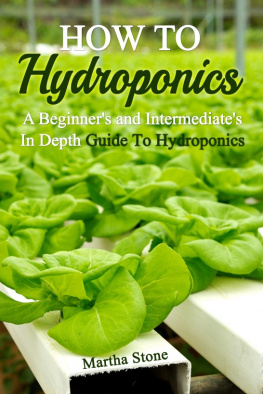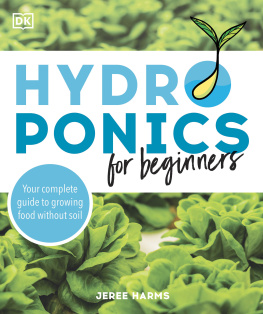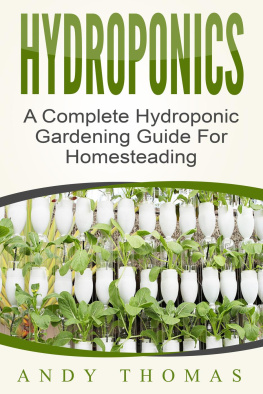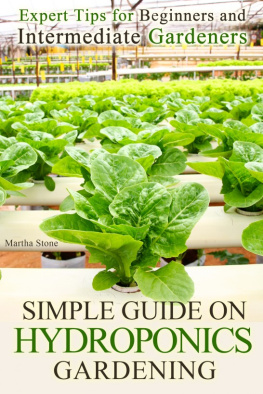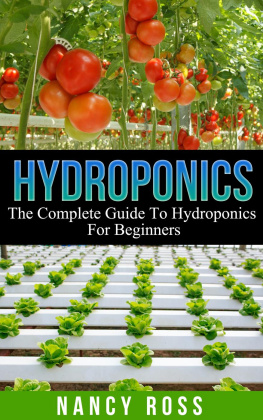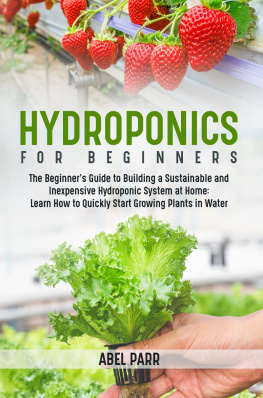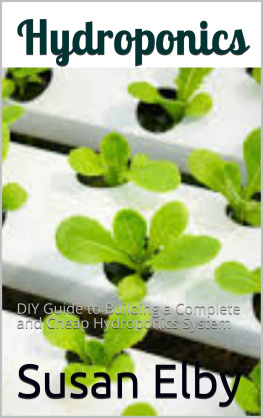How To Hydroponics
A Beginner's and Intermediate's InDepth Guide To Hydroponics
By Martha Stone
Copyright 2014 MarthaStone
Smashwords Edition
Smashwords Edition,License Notes
This ebook is licensed for your personalenjoyment only. This ebook may not be re-sold or given away toother people. If you would like to share this book with anotherperson, please purchase an additional copy for each recipient. Ifyoure reading this book and did not purchase it, or it was notpurchased for your use only, then please return to your favoriteebook retailer and purchase your own copy. Thank you for respectingthe hard work of this author.
Table of Contents
Beginner'sIntroduction
Hydroponic gardening is a method of growing plants without the useof soil. Instead, plants are cultivated in a nutrient-richsolution. This particular gardening method is gaining popularitynot only in commercial but also domestic use. In fact, this type ofgardening method is preferred among those who live in apartmentsbecause this particular system does not require too much space toset up.
The Early Beginnings ofHydroponics
Although hydroponics gardening became a hype just recently, theidea of growing plants without soil has been around for more thanfour centuries. The earliest account of hydroponics gardening wasrecorded in 1627 in the book Sylva Sylvarum written by FrancisBacon. Soon after, water culture became a popular research methodin studying plants. However, little was understood abouthydroponics system particularly the types of elements that areessential to the growth of plants in such propagationtechnique.
In 1842, German botanists Wilhelm Knop and Julius von Sachspublished a list of the nine elements that are essential to theplant growth in hydroponic system. This then led to the furtherdevelopment of the method. In fact, the study published by the twoGerman botanists became the basis of modern day hydroponics.
However, the term hydroponics was coined only later in 1937 whenWilliam Frederick Gericke from the University of California atBerkeley promoted his very own concoction of the nutrient-richsolution for his backyard garden. He first grew giant tomatoesusing only his nutrient solution which caused quite a stir in thescientific world. The first term given to hydroponics wasaquaculture but seeing that this term has already been used andapplied in growing aquatic animals such as fish, he then coined theterm hydroponics from the Greek words hydro- (water) + ponos(labor).
Gericke's work prompted a lot of curiosity from the scientificworld but his refusal to reveal his secrets as well as his entirestudy has resulted to his premature resignation in the Universityof California. However, two men from the same university, DennisHoagland and Daniel Arnon, made another study to debunk Gericke'sexaggerated claim about hydroponics. Instead of debunking Gericke'sclaim, what they did was that they even further developed thesystem. In fact, one of the proponents developed his own nutrientsolution that is still used even today - the Hoagland Solution.Hydroponic gardening is used not only by ordinary gardeners butalso by big institutions such as NASA in the attempt to grow foodin their space programs.
Today, this type of gardening method is considered as anestablished branch in Agronomy. Because of the complexity of theplant requirements as well as the different factors that influencethe growth of the plants using this propagation technique,hydroponics is widely studied and is still being further developedeven until now.
Chapter 1: What isHydroponics?
Hydroponics gardening is unlike conventional gardening in manyways. This type of gardening method involves cultivating plantsusing a nutrient-rich solution. There are different types ofhydroponics gardening but before delving deeper with these systems,it is crucial to understand the basics of hydroponics.
In hydroponics gardening, the plants are planted in soillesscontainer with a neutral growing medium placed loosely at the baseof the plant for support. The plants' roots are then submerged orexposed to a reservoir full of the nutrient-rich solution. Theplants are literally fed with the nutrient-rich solution from timeto time to prevent the roots from drying out and the plants fromdying out. The reservoir is the lifeline of the plants as it iswhere they get their nourishment from. In the succeeding chapters,the different types of hydroponic systems will be discussed.
A. The Advantages ofHydroponics Gardening
There are many advantages and disadvantages to growing plants usingthe hydroponics system. Listed below are the many benefits ofcultivating plants in a soilless method.
There is no need for soil - In conventionalgardening, soil is required to propagate plants but the problem isthat most gardeners find it difficult as well as expensive to buygarden soil. Thus hydroponic gardening removes the hassle of buyingsoil to raise the plants.
The water in the system can be recycled -Another advantage is that the water used in hydroponics can berecycled unlike in conventional gardening. In hydroponics, peopledo not only conserve water but also save on their water billstoo.
Easily controls the nutrition of plantswhich allows gardeners to lower or increase the nutritionrequirements depending on what they want to achieve.
Crops are high yielding - There have beenmany accounts from hydroponics gardeners worldwide about producinghigh yielding crops using this method. The reason for this is notonly to be accounted to the nutrient-rich solution but to the factthat plants grown using this method are raised inside a controlledenvironment.
Crops have overall better health - Since thehydroponics method grow plants inside a controlled environment,plants are not threatened by pests compared to when they are grownoutside.
B. The Disadvantages ofHydroponics Gardening
While there are many advantages of cultivating plants throughhydroponic systems, there are still some disadvantages to thisparticular technique. The first and the most noticeable advantageis that the absence of soil can easily lead to the rapid death ofthe plant. The soil acts as a buffer and any failure in thisparticular system can mean rapid decline to the overall health ofthe plant. On the other hand, since the plants are constantlyexposed to moisture, there is also a high risk of pathogeninfection. Lastly, bigger plants are difficult to grow using thissystem because the absence of soil makes it difficult for plants tobuttress themselves to the container. Thus, this particular systemis only efficient in growing small plants like herbs, tomatoes andleafy vegetables.
Hydroponics gardening is a fun method of growing plants. There arenow different hydroponic kits that are sold in the market so thateven novice gardeners can start producing crops like professionalhydroponic gardeners.
Chapter 2: BeginnersGuide to Successful Hydroponics
Contrary to popular belief growing your own vegetables in ahydroponic system is not difficult at all. What you need to do isto make sure that you understand the basic in hydroponic gardening.When starting your own hydroponic garden, it is important that youunderstand the differences with conventional gardening and soillessgardening.
As defined in the previous chapter, hydroponics is the process ofcultivating plants without the use of soil. With this information,you can then deduce that the 0environment in hydroponic isdifferent from the environment of conventional gardening. For thesereasons, it is crucial to understand the basics in establishing asuccessful hydroponic system. The succeeding sections will discussthe different thing that you need in order to have a successfulsoilless garden.
Next page
